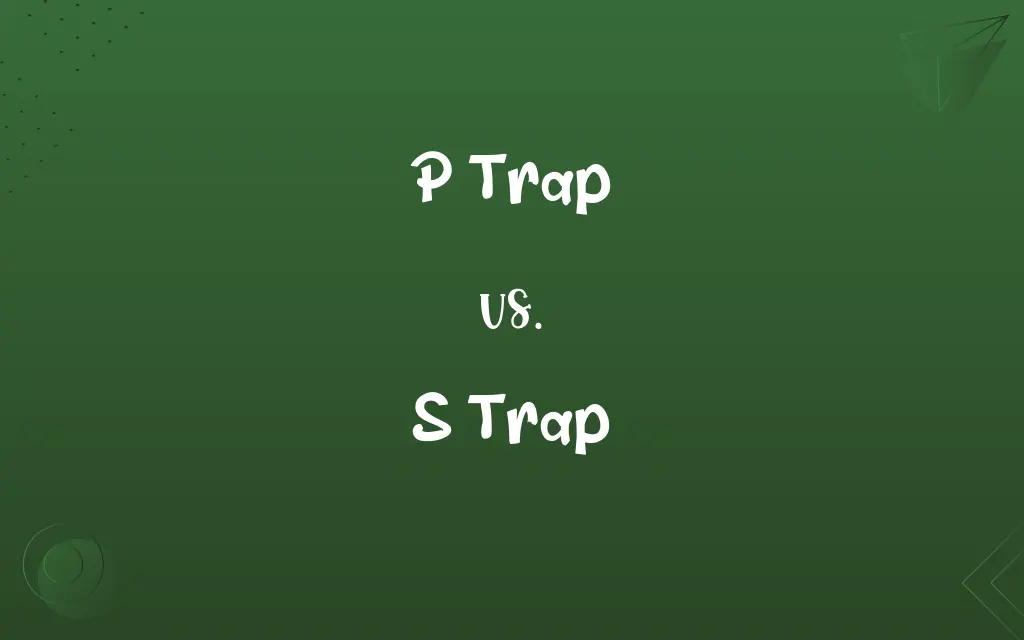P Trap vs. S Trap: Know the Difference

By Hifza Nasir & Shumaila Saeed || Published on March 8, 2024
P-traps are plumbing fixtures that prevent sewer gases from entering homes, using a water seal created by a P-shaped bend. S-traps, with an S-shaped bend, can siphon the trap dry, leading to potential gas entry.

Key Differences
P-traps are designed with a horizontal overflow pipe, creating a water seal that blocks sewer gases. They're commonly used in modern plumbing systems due to their effectiveness and building code compliance. S-traps, on the other hand, have an S-shaped pipe that connects directly to the drainage, which can lead to the water seal being siphoned away, risking sewer gas leakage into the home.
Shumaila Saeed
Mar 08, 2024
The design of P-traps allows for easy cleaning and maintenance, as they often come with cleanout plugs. This accessibility prevents blockages and ensures the integrity of the water seal. S-traps lack this feature, making them more prone to clogs and harder to maintain, which is why they're less favored in contemporary plumbing practices.
Hifza Nasir
Mar 08, 2024
Building codes in many areas now require the use of P-traps instead of S-traps. This shift is due to the P-trap's ability to maintain a consistent water seal, whereas S-traps can lose their seal through siphoning, especially during heavy water flow, leading to potential health hazards.
Shumaila Saeed
Mar 08, 2024
In terms of installation, P-traps require more space due to their horizontal extension but offer greater flexibility and safety. S-traps, while compact and suited for tight spaces, are often replaced with P-traps during renovations or new installations to meet modern plumbing standards and ensure safety.
Hifza Nasir
Mar 08, 2024
Despite their differences, both P-traps and S-traps serve the essential function of keeping sewer gases out of homes. The choice between them depends on building codes, space availability, and the specific plumbing needs of a structure.
Shumaila Saeed
Mar 08, 2024
ADVERTISEMENT
Comparison Chart
Sewer Gas Prevention
Water seal prevents gas entry
Risk of siphoning dry, allowing gas entry
Hifza Nasir
Mar 08, 2024
Maintenance
Often includes cleanout plug for easier maintenance
More prone to clogs, harder to clean
Hifza Nasir
Mar 08, 2024
Building Code Compliance
Generally required by modern codes
Often not compliant with modern codes
Shumaila Saeed
Mar 08, 2024
Installation Considerations
Requires more space, offers flexibility
Compact, but may require replacement
Shumaila Saeed
Mar 08, 2024
ADVERTISEMENT
P Trap and S Trap Definitions
P Trap
Requires more space for installation due to its horizontal layout.
The cabinet had to be modified to accommodate the P-trap’s size.
Hifza Nasir
Feb 28, 2024
S Trap
An S-shaped plumbing fixture that can allow sewer gases into buildings if the water seal is siphoned.
The old S-trap under our sink was replaced to prevent odors.
Shumaila Saeed
Feb 28, 2024
P Trap
Offers a reliable solution for maintaining a safe and odorless environment.
Installing a P-trap was crucial for the health and safety of the home.
Hifza Nasir
Feb 28, 2024
S Trap
Can pose health risks if not properly maintained.
Neglecting the S-trap maintenance could lead to hazardous sewer gases entering the home.
Shumaila Saeed
Feb 28, 2024
P Trap
Complies with most modern building codes.
Our bathroom renovation included updating the drainage to a P-trap to meet code requirements.
Shumaila Saeed
Feb 28, 2024
ADVERTISEMENT
S Trap
More compact and suited for tight spaces but prone to maintenance issues.
Despite its compact size, the S-trap frequently clogged and was difficult to clean.
Hifza Nasir
Feb 28, 2024
P Trap
A plumbing fixture with a P-shaped curve that retains water to prevent sewer gases from entering buildings.
The plumber installed a P-trap under the sink to ensure the kitchen remained odor-free.
Shumaila Saeed
Feb 28, 2024
S Trap
Often replaced during plumbing upgrades for compliance and efficiency.
The renovation project included replacing the S-trap with a P-trap for better performance.
Hifza Nasir
Feb 28, 2024
P Trap
Designed for easy maintenance with a cleanout plug.
The P-trap’s cleanout plug made it simple to clear a blockage without professional help.
Hifza Nasir
Feb 28, 2024
S Trap
Not typically compliant with modern plumbing codes.
The inspector noted the S-trap’s non-compliance with current plumbing standards.
Dua Fatima
Feb 28, 2024
Repeatedly Asked Queries
Why are P-traps preferred over S-traps?
P-traps are preferred because they maintain a reliable water seal and comply with modern building codes, unlike S-traps which can siphon dry and allow sewer gas entry.
Shumaila Saeed
Mar 08, 2024
What is the main difference between a P-trap and an S-trap?
The main difference is their shape and functionality; P-traps prevent sewer gas entry with a water seal in a P-shaped bend, whereas S-traps can lose this seal and allow gases to enter.
Shumaila Saeed
Mar 08, 2024
Are P-traps more expensive than S-traps?
The cost can vary, but P-traps may be slightly more expensive due to their design and compliance features; however, they offer better safety and maintenance benefits.
Shumaila Saeed
Mar 08, 2024
Can I replace an S-trap with a P-trap myself?
While it's possible for someone with DIY plumbing experience to replace an S-trap with a P-trap, it's recommended to consult a professional to ensure it complies with local codes and is installed correctly.
Hifza Nasir
Mar 08, 2024
What materials are P-traps and S-traps made from?
Both P-traps and S-traps can be made from various materials, including PVC, ABS plastic, brass, and stainless steel, each offering different benefits in durability and compatibility.
Hifza Nasir
Mar 08, 2024
Can an S-trap be replaced with a P-trap?
Yes, an S-trap can often be replaced with a P-trap to improve plumbing safety and code compliance.
Hifza Nasir
Mar 08, 2024
Do all sinks need a P-trap?
Yes, to prevent sewer gas from entering buildings, all sinks and drain fixtures should have a P-trap or an equivalent device that maintains a water seal.
Shumaila Saeed
Mar 08, 2024
Is it legal to install an S-trap in new construction?
It is generally not legal to install an S-trap in new construction in most jurisdictions due to building code requirements favoring P-traps for their reliability in preventing sewer gas entry.
Dua Fatima
Mar 08, 2024
How does a P-trap prevent sewer gases from entering a home?
A P-trap prevents sewer gases from entering a home by maintaining a constant water seal within its P-shaped bend, which acts as a barrier against the gases.
Hifza Nasir
Mar 08, 2024
Why can S-traps siphon dry, and what does that mean?
S-traps can siphon dry during high water flow, which means the water seal that blocks sewer gases can be pulled out of the trap, potentially allowing gases to enter the home.
Hifza Nasir
Mar 08, 2024
What happens if a P-trap dries out?
If a P-trap dries out, it can no longer prevent sewer gases from entering the home. Regular use or adding water to the drain can prevent or remedy a dry P-trap.
Hifza Nasir
Mar 08, 2024
Are there any alternatives to P-traps and S-traps?
Yes, there are alternatives like the bottle trap and the HepvO waterless valve that serve similar functions but with different designs suited for specific situations.
Hifza Nasir
Mar 08, 2024
Can P-traps be used in all plumbing fixtures?
P-traps are suitable for most plumbing fixtures, including sinks, bathtubs, and showers, due to their effective design in preventing sewer gas leakage.
Dua Fatima
Mar 08, 2024
How do building codes affect the choice between P-traps and S-traps?
Building codes typically mandate the use of P-traps over S-traps due to their effectiveness in maintaining a water seal and preventing sewer gases from entering buildings, affecting the choice during construction or renovation.
Hifza Nasir
Mar 08, 2024
How often should I check or clean my P-trap?
It's a good practice to check and potentially clean your P-trap annually or more frequently if you notice slow drainage or odors, to ensure it's functioning properly.
Shumaila Saeed
Mar 08, 2024
Share this page
Link for your blog / website
HTML
Link to share via messenger
About Author
Written by
Hifza NasirCo-written by
Shumaila SaeedShumaila Saeed, an expert content creator with 6 years of experience, specializes in distilling complex topics into easily digestible comparisons, shining a light on the nuances that both inform and educate readers with clarity and accuracy.








































































